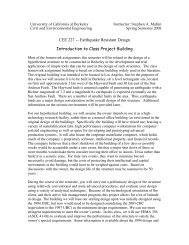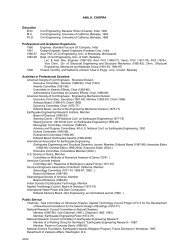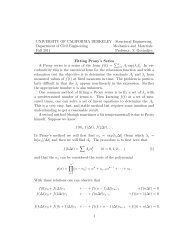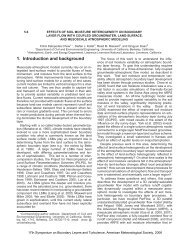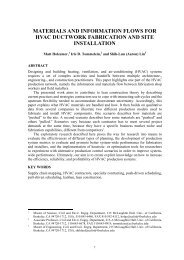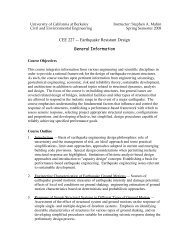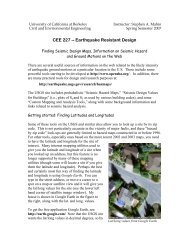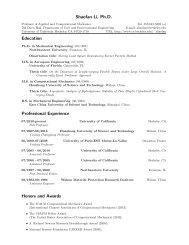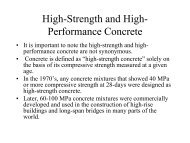304 G. Wang, S.F. Li / Theoretical and Applied Fracture Mechanics 42 (2004) 303–316In principle, a more realistic micromechanics<strong>model</strong> and a feasible homogenization schemeshould lead to a better constitutive law at macrolevel.For Gurson <strong>model</strong>, failure mechanism dueto void growth is supported by many experimentalobservations on failures of ductile <strong>material</strong>s (e.g.[8,10,20,24,29]). On the other hand, in most brittle,quasi-brittle, and even some ductile <strong>material</strong>s(such as concrete, rocks, ceramics and some metals),<strong>material</strong>Õs failure mechanism may be attributedto propagation, nucleation and coalescenceof micro-<strong>crack</strong>s as well. Although several micro<strong>crack</strong>based <strong>damage</strong> <strong>model</strong>s have been proposedto describe elastic <strong>damage</strong> processes (e.g.[4,9,15,16,19] and others), few micro-<strong>crack</strong> <strong>damage</strong><strong>model</strong>s are available <strong>for</strong> inelastic <strong>damage</strong>processes.The motif of contemporary micromechanics isaimed at discovering unknown but importanteffective constitutive in<strong>for</strong>mation by homogenizingmassive numbers of micro-objects with simplestructures. In this paper, new <strong>cohesive</strong> <strong>damage</strong><strong>model</strong>s are derived based on homogenization ofrandomly distributed <strong>penny</strong>-<strong>shaped</strong> <strong>cohesive</strong> <strong>crack</strong>s(Barenblatt–Dugdale type [1,2,7]) in an elasticRVE. At micro-level, the <strong>cohesive</strong> <strong>damage</strong> <strong>model</strong>mimics realistic interactions among atomistic bond<strong>for</strong>ces at <strong>crack</strong> tips, hence it may capture the overall<strong>damage</strong> effects due to <strong>crack</strong> opening andpropagation.In general, <strong>damage</strong> means <strong>material</strong> degradationcaused by defects or de<strong>for</strong>mation. Damage may bedefined as surface separations, permanent latticedistortion, various irreversible effects due to endochronicdissipation etc. In the context of thispaper, the term <strong>damage</strong> is strictly referred to the<strong>material</strong> degradation due to specific defect—permanent<strong>crack</strong> opening, or volume fraction of permanentmicro-<strong>crack</strong> opening, which may beviewed as a second phase in a composite <strong>material</strong>.This definition of <strong>damage</strong> has been extensivelyused in engineering literature. The definition of<strong>damage</strong> used in Gurson <strong>model</strong> (e.g. void growth)belongs to this category as well.To distinguish the <strong>damage</strong> caused by deviatoricstress, such as dislocation, disclination, and surfacesliding, with the <strong>damage</strong> caused by hydrostaticstress, such as permanent <strong>crack</strong> opening,may simplify constitutive <strong>model</strong>ing. Of course inreality, <strong>material</strong> <strong>damage</strong> may be susceptible andrelated to both hydrostatic and deviatoric stressstates and it is sensitive to their combinations.However, it is a reasonable approximation to assumethat the <strong>damage</strong> due to permanent <strong>crack</strong>opening is only related to hydrostatic stress state,which renders a tractable homogenization solution.Throughout this paper, vectors and tensors aredenoted as bold-face letters, while their componentsare written as italic. The symbol ÔÆÕ denotesinner product of two vectors a Æ b = a i b i or contractionof adjacent indices of a vector and a tensor(e.g. n Æ r = n i r ij ). The symbol Ô:Õ denotes aninner product of two second-order tensors (e.g.c:d = c ij d ij ) or a double contraction of adjacentindices of tensors of rank two and higher (eg.C:e = C ijkl e kl ).2. Average theorem <strong>for</strong> an RVE with <strong>cohesive</strong><strong>crack</strong>sOne of the fundamental concept in classicalmicromechanics is so called representative volumeelement (RVE). An RVE <strong>for</strong> a <strong>material</strong> point usuallycontains a very large number of microstructuresand it is statistical representative of thelocal continuum properties. Despite heterogeneityof microstructures, averaged stress or strain propertiesof an RVE can be derived under specificboundary conditions. For an RVE with randomlydistributed <strong>cohesive</strong> <strong>crack</strong>s inside, traditionalmicromechanics averaging theory <strong>for</strong> traction-freedefects [23] cannot be applied. In this section, averagingtheorem <strong>for</strong> RVE containing <strong>cohesive</strong> defectswith constant <strong>cohesive</strong> traction would bederived <strong>for</strong> our purpose.Define the volume average operator h Æ i, anddefine macro stress tensor R as the volume averageof micro stress tensor in an RVE,R ¼hri ¼ 1 ZrdVð1ÞV VFirst, consider the average stress in a three-dimensionalelastic RVE with a single <strong>penny</strong>-<strong>shaped</strong>Barenblatt–Dugdale <strong>crack</strong> at the center. Neglect-
G. Wang, S.F. Li / Theoretical and Applied Fracture Mechanics 42 (2004) 303–316 305ing body <strong>for</strong>ce, the equilibrium equation inside anRVE takes the <strong>for</strong>mrr ¼ 0 8x 2 V ð2ÞAssume that the prescribed tractions on the remoteboundary of the RVE (oV 1 ) are generatedby a constant stress tensor r 1 . Let oV ec denotetraction-free part of a <strong>cohesive</strong> <strong>crack</strong> surface,and let oV pz denote the <strong>cohesive</strong> part of the <strong>crack</strong>surface where constant traction <strong>for</strong>ce t is applied.Using divergence theorem and Eq. (2), it isstraight<strong>for</strong>ward to show thathri ¼ 1 ZrdV ¼ 1 Zfr ðr xÞg T dVV V V V¼ 1 ZZr 1 dV fn ðr xÞg T dSV VoVZecfn ðr xÞg T dSoV pzZ¼ r 1 1fn ðr xÞg T dSV oV pzZ¼ r 1 1x tdSð3ÞV oV pzwhere t is the constant <strong>cohesive</strong> traction.Note that oV pz = oV pz+ [ oV pz and the surfaceareas joV pzþ j¼joV pz j¼ 1 joV 2 pzj, where subscriptÔ+Õ and Ô Õ are used to distinguish upperand lower part of the <strong>crack</strong> surfaces. So the lastterm in Eq. (3) becomesZ1x tdS ¼ 1 V oV pzVZZx t þ dS þoV pzþoV pz¼ 12V x ðtþ þ t ÞjoV pz j¼ 0x t dS!ð4Þwhere t + = t are the <strong>cohesive</strong> tractions actingon oV pz+ and oV pz respectively.There<strong>for</strong>e, the average stress inside the RVEwill equal to remote stressR ¼hri ¼r 1ð5ÞBy superposition, it is straight<strong>for</strong>ward to generatethis result to an RVE with N <strong>cohesive</strong> <strong>crack</strong>s randomlydistributed inside (see Fig. 1),hri ¼r 1 1VX Na¼1ZoV ðaÞpzx t ðaÞ dS ¼ r 1ð6ÞFig. 1. Randomly distributed micro-<strong>crack</strong>s within an RVE.Hence, the averaging theorem follows:Theorem. Suppose1. an elastic representative volume element containsN Barenblatt–Dugdale <strong>penny</strong>-<strong>shaped</strong> <strong>crack</strong>s with<strong>cohesive</strong> tractions in the <strong>cohesive</strong> zones;2. the tractions on the remote boundary of the RVEis generated by a constant stress tensor, i.e.,t 1 = n Æ r 1 and r 1 is constant.Then, macro stress of the RVE equals to the remoteconstant stress, i.e. R = hri = r 1 .3. Penny-<strong>shaped</strong> <strong>crack</strong> under uni<strong>for</strong>m triaxialtensionBe<strong>for</strong>e homogenization, the analytical solutionof three-dimensional (3D) <strong>penny</strong>-<strong>shaped</strong> <strong>crack</strong> inan RVE that is under uni<strong>for</strong>m triaxial tension isoutlined in this section (see Fig. 2).Penny-<strong>shaped</strong> Dugdale <strong>crack</strong> problem has beenstudied by several authors. The early contributionwas made by Keer and Mura, who used the Trescayield criterion to link the <strong>cohesive</strong> strength tomicro yield stress [17]. In their study, only uniaxialtension loading was considered. More recently,



